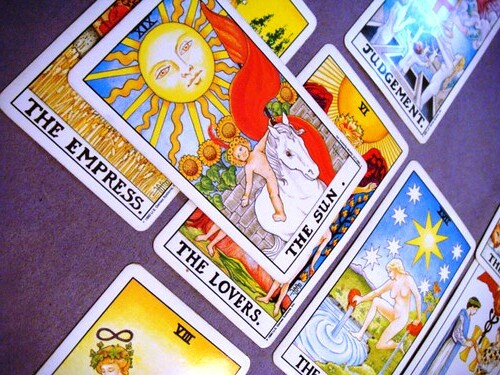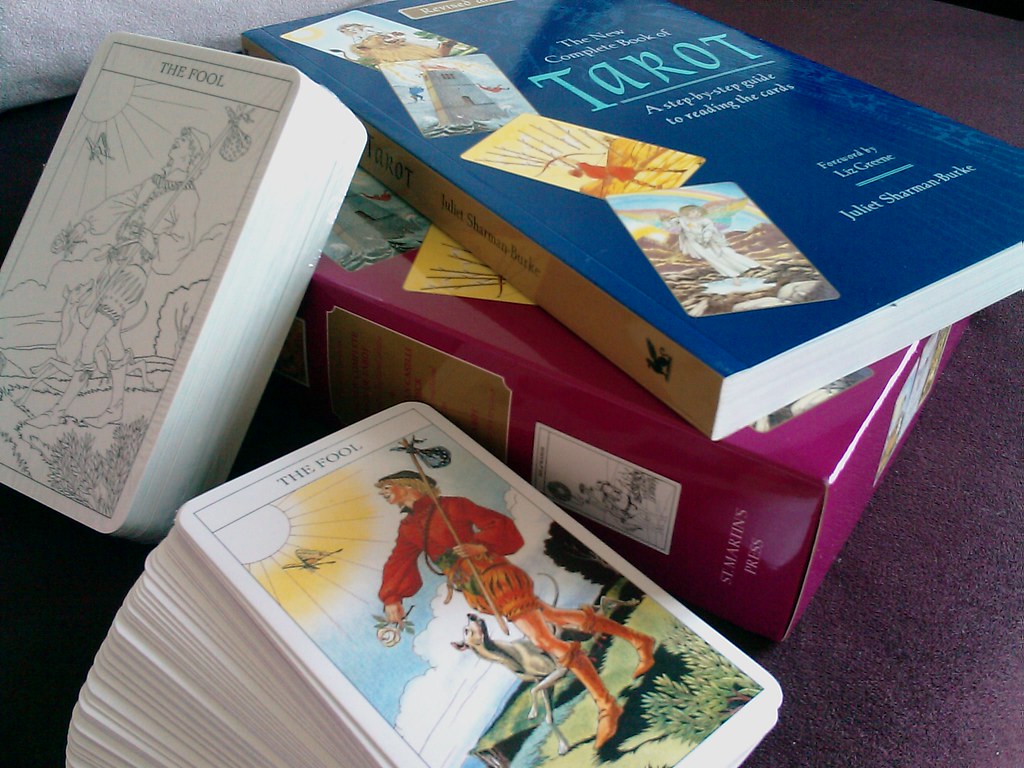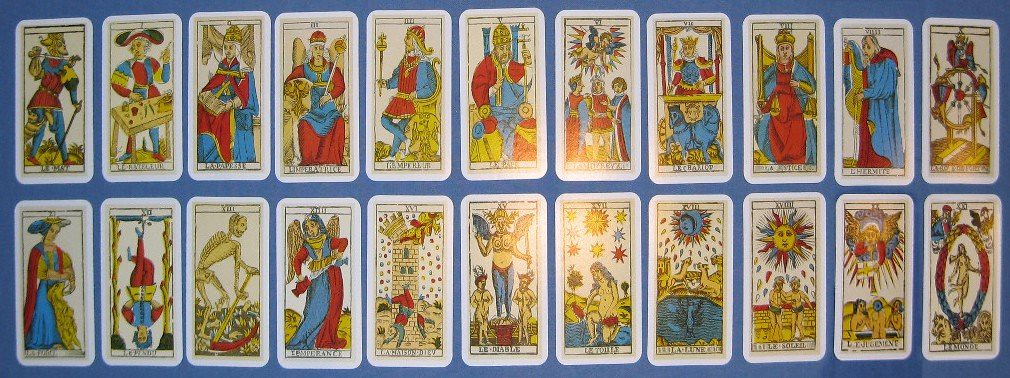Tales of Tarot

In an era of uncertainty, everyone searches for meaning. Some turn to Fox News, some turn to tarot. I personally think one of those things is a lot of fantasy made up by a bunch of crazy people and the other a completely reliable source of information displayed in cards. Tarot was started in Italy as a card game called tarocchi appropriati, where players would pick cards and write poems based on what they chose. Important families would have special sets of cards made as a show of power and wealth for when their guests would come over to play cards with them. Tarot quickly made its way to France, where it adopted the current name "tarot" and stayed in social circles as a fun way to have meanings based on the cards. As time passed, the cards took on more meaning and people started to give "readings", mystical explanations of the past, present, and future, based on which cards the other person chose. In the late 1960's, tarot was brought to mainstream America through the work of Stuart Kaplan, who wrote a very detailed text called Cards for Fun and Fortune published in 1968 and still being sold today.
Image Credit: "My Tarot Decks" by imeleven is licensed under CC BY-NC-ND 2.0The idea that your energy can control what you pick seems a bit random, like gambling, but talk to anyone who does tarot, and you’ll find a rock-solid belief in the abstractness of the cards themselves. Every time I have received a reading it has been so specific to my life and situation that I have never once doubted what I chose. Tarot decks have 78 cards; 22 major arcana, 56 minor arcana. For every sign in the zodiac there is a major arcana, so 12 zodiac arcana means that the other 20 remaining major arcana in a deck correspond to luminary bodies such as the moon, the sun, and the planets; excluding Earth. Major arcana are grand motifs -- love, balance, and gendered power. Minor arcana are situational. These sets can be categorized by number and suit. The suits are elements: fire (wands), air (swords), earth (pentacles), and water (cups). You can study the numbers by even and odd, as well as study the progression of a cycle (10, for example, would be a sign you are nearing the end end of a cycle). Swords can represent thoughts. Wands are passionate and creative actions. Pentacles are hard work, time, and effort. Cups are emotions. Tarot works today as a way for young people to both give and receive guidance, just like how it has worked for past decades. I interviewed two tarot aficionados who are also studying at AUP, Shawna, from Memphis, Tennessee, and Lea, from Orange County, California. Here is what they have to say.
Shawna has been giving readings for only a few months but is already very experienced. She owns three decks, but only one is tarot, the other two are known as oracle decks. Tarot decks explain the major arcana through motifs and minor arcana through situations. If you have a lot of reverse major arcana, the oracle decks are for further insights and clarification. Most of the content, though containing major themes, delivers messages differently based on planetary alignment and the card’s design.
When asked about what tarot means to her, Shawna responded by speaking about one of her favorite theoretical tools, the significance of coincidence. “My view of [tarot] is scientific. The metaphysical and physical are intertwined. I think math is a good comparison to tarot. Math is a visual representation in an attempt to understand something, like quantum physics. Something that we can't explain, like the significance of coincidence or the butterfly effect. This collective energy fuels our connective existence."
I continued by asking about how she personally interprets a reading and she responded, “All of the circumstances that have brought me to my current state [as the reader] and the energy of the person whose cards are being read is important. The specific question they have in mind, that matters too. I read the cards with them and this time specifically, this time while I am reading, is all a culmination of events. By applying a circumstance to this question, giving my response, and then them thinking of how this analysis relates to their experience is tarot. It is not supposed to tell the future; that is impossible, you change your mind all the time, right? The point is not to predict the future but to grow and to reflect on how you can change your present to move forward in a positive way to your future. It is just a way for you to reflect on the situation, a meditative tool.”
Lea has been interested in astrology (the reading of star charts) and palmistry (the reading of palms) for 4 years, but has only studied tarot for the last six months. I asked them about their start, and Lea responded, “One of my friends started watching tarot readings online on YouTube, and I started watching them and was like, “Whoa, these are really accurate.” I bought my first tarot deck here in Paris, at La Flamme Divine in the 14th arrondissement near Montparnasse.” When I asked Lea about generalization as well, and what they thought of people thinking tarot can apply to anyone. They responded, “For me, the whole philosophy behind tarot, astrology, and other forms of divination is finding common stories. Think of Joseph Campbell’s philosophy of myths and legends -- it relates back to archetypes, which share traits with the core of tarot with repetitive stories.”
When I confronted the elephant in the room and asked about the people who think that tarot is just vague and non-applicable to daily life, Lea surprised me by responding with a partial affirmation of that statement, “The point is that if tarot seems vague in its description or you feel that the reader may be making up things to fit the situation -- it kind of is the point, everything is the same and every situation is a reflection of the universal cycles we go through. Tarot is not vague or general or bullshit, but if you receive a tarot reading and you think this could apply to anyone or any situation, the point is to look for the commonalities in your situation and how they are reflected in the cards. You are not the first person to go through this, and you're definitely not the last.” Tarot is the substantiation of the greater myths that make up our existence, and generality can be expected; but these stories relate to all of us, and if you self-analyze, you can find the truth in terms of the situation, and if you open yourself up to identifying how these larger universal mythic themes apply to your daily life, then that in and of itself is magic.
Another comparison Lea made to understanding tarot for beginners is learning languages. “I say tarot is a language in that you can study it by yourself; vocabulary, grammatical structure, composition...watch[ing] others speak the language...but what will help you most is speaking the language with other people.” Most decks come with books that explain each card and can offer insight into the readings you receive. Once you develop your skills and practice “speaking the language” of tarot with others, you become more fluent. Lea describes the books that come with the cards similar to a phrasebook for a new language. “You can use a phrasebook to get around [while learning the language], but once you practice enough you can become fluent through interacting with others.”
Image Credit: "Tarot Major Arcana" by ukslim is licensed under CC BY-NC-SA 2.0To summarize these two interviews, it seems that the common belief among practitioners is that tarot is the substantiation of the greater myths that make up our existence, and generality can be expected; but these stories relate to all of us, and if you self-analyze, you can find the truth in terms of the situation. If you then open yourself up to identifying how these larger universal mythic themes apply to your daily life, then that in and of itself is magic.
If you’re still unconvinced, I suggest going to a tarot reading with a professional or even getting your own set of cards and trying it out. You can get an hour-long reading at Arc en Ciel on 3 Rue Jean-Macé, 75011 Paris for 70 euro. If that’s out of our price range but you are still interested, just buy your own set! You can go buy tarot cards for under 20 euro at my favorite shop, which has been recommended by many esoteric friends of mine as the most ethical esoteric store in Paris, called Libraire Inconnu at 8 Rue de l'Odéon, 75006 Paris.









